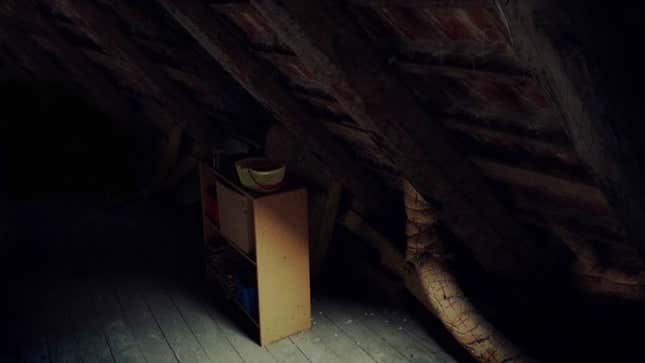
ITHACA, NY—Describing the vast, undisturbed regions as one of the last true frontiers on the planet, a report published Tuesday by researchers at Cornell University has found that at least 79 percent of the world’s attic space remains unexplored.
According to the report, the little-understood lofted areas of most homes across the globe have not been studied beyond a radius of approximately an arm’s length from their entrance hatches, leaving what remains in their further reaches a matter of pure speculation.
“Apart from a small region illuminated by a single pull-chain light bulb, we know very little about attics,” said the report’s lead author, professor Neal Hutchison, noting a lack of data on both the size and contents of the elevated enclosures. “While we suspect that some form of insulation could exist up there, perhaps along a wall or the roofline, we haven’t yet been able to travel far enough inside to confirm or deny that.”
“Right now, most of our explorations involve climbing up a stepladder or the built-in pull-down stairs, quickly poking our head inside, and returning with almost no new information,” Hutchison continued. “Even after all these years of retrieving Christmas tree stands from right inside the entryway, the darkest recesses of our world’s attics remain a complete mystery to us.”
Though for years researchers have embarked on specialized missions by shining flashlights into attics and waving them around in different directions, the report stated they have never penetrated more than a few feet beyond the already well-documented zone near the top of the stairs.
Many past expeditions into the deeper recesses of uncharted attics have reportedly been forced to turn back due to dust, poor ventilation, and evidence of potential spiders. Sources confirmed a recent attempt to explore an unmapped Plano, TX attic encountered an old crib, but the mission was aborted due to atmospheric conditions described as “thick” and “musty.”
“Are there board games up there? Maybe old baby clothes?” said Hutchison, who mentioned a colleague’s hypothesis that Dad’s bowling trophy may reside in a remote corner of the attic. “Can fabrics made of natural fibers even survive in such harsh, moth-infested conditions? Ultimately, gaps in our knowledge will continue to exist until we dust off and open some of these boxes that appear to have been taped shut decades ago.”
“Attic exploration will remain at a standstill until we develop the capacity to stoop down beneath a low ceiling, lantern in hand, to see if the good family china is back there somewhere,” Hutchison added.
Hutchison told reporters that attic research has lagged far behind comparable studies into the world’s cellars and basements, which in recent generations have been found to contain gardening tools, bicycles in a state of disrepair, and the trunk with the winter bedding. The researcher remarked that these better-understood spaces often hold items with potential resale value, such as skis, and that some had even been developed into finished rec rooms.
“One is tempted to ask whether our attics, too, could be colonized, perhaps made into an apartment that could be rented out to provide some extra income,” Hutchison said. “There may be valuable resources hidden above our heads right now, but unfortunately all we do when we’re up there is pick up a couple things, carefully put them back, and then wipe our dust-covered hands on our pants before heading back downstairs.”
“Of course, attic research comes with a very unique set of challenges,” he continued. “There are gaps between the beams up there, and all it takes is one false step for a foot to go through the ceiling and for research to be set back another five years.”